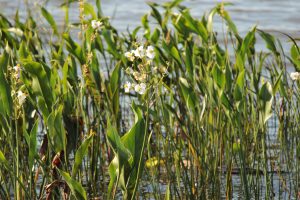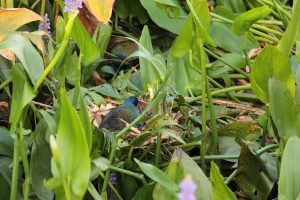
As Floridians, we love our freshwater resources. Did you know Florida has over 1 million acres of freshwater? That’s about the size of Rhode Island! Many of our fondest memories are of boating, fishing, or water skiing in freshwater systems across the state. Other activities include kayaking our famous spring runs or birdwatching among the numerous wetlands. While the water itself is often the focus, aquatic plants are essential to any healthy freshwater system and provide a variety of benefits. There are three main ways aquatic plants serve Florida’s unique and vast aquatic ecosystems.
Habitat. Whether completely submerged under water or extended into the air, plants provide habitat for a wide variety of critters. Small fish and insects will use these plants to hide from predators. In turn, these plants then attract wading birds and larger fish that are looking for a meal. These predator/prey relationships are necessary for a healthy and complex food web where large amounts of nutrients are being consumed and recycled in the ecosystem. Without these plants you will have fewer insects, fewer fish that feed on the insects, and fewer birds feeding on those fish.
Oxygen. Just like humans, our aquatic friends need oxygen too. While oxygen diffuses from the air into the water, underwater plants and algae add oxygen directly to the water during photosynthesis (just like trees release oxygen into the air). So having a variety of healthy plants allows the fish to breathe easily.
Water Clarity. When you have more plants in a lake, you generally have much clearer water. There are two reasons for this… 1. Plants provide a place for periphyton (pair-AH-phi-ton) to attach and grow. Periphyton is a complex mix of algae, bacteria, and other microbes that remove nutrients from the water. Less nutrients mean less algae and clearer water. 2. As plants grow, older leaves fall to the bottom and become “muck”. This muck layer is high in nutrients, but simply sits on the bottom and waits to be eaten by crayfish and insects. However, if the muck gets stirred up with wind, they can start to decay and rapidly release their nutrients and sometimes causing algae blooms. But plants stabilize the water and help keep this muck in place, resulting in clearer water.

The key to a healthy ecosystem is a wide variety of native plants. Native plants are unique in that they work in harmony with the local ecosystem, this can mean having native critters that rely on the plant for survival and leaving room for other native plants to thrive. You want some plants that start early in the season and others that grow later in the year. You also want plants that prefer shallow water and others that do best in deeper water. With this diversity of plants, you have a balanced ecosystem that supports the recreational activities we enjoy and the wildlife we love.
Stay tuned for our next blog, where I discuss the need for invasive plant management in aquatic systems!
Questions or comments can be sent to the UF/IFAS CAIP communications manager at caip@ifas.ufl.edu. Follow UF/IFAS CAIP on Instagram.
Subscribe for more blogs like this one.
UF/IFAS Center for Aquatic and Invasive Plants. Turning Science Into Solutions.
Did you find this post helpful or interesting? Click the heart below!
 7
7
